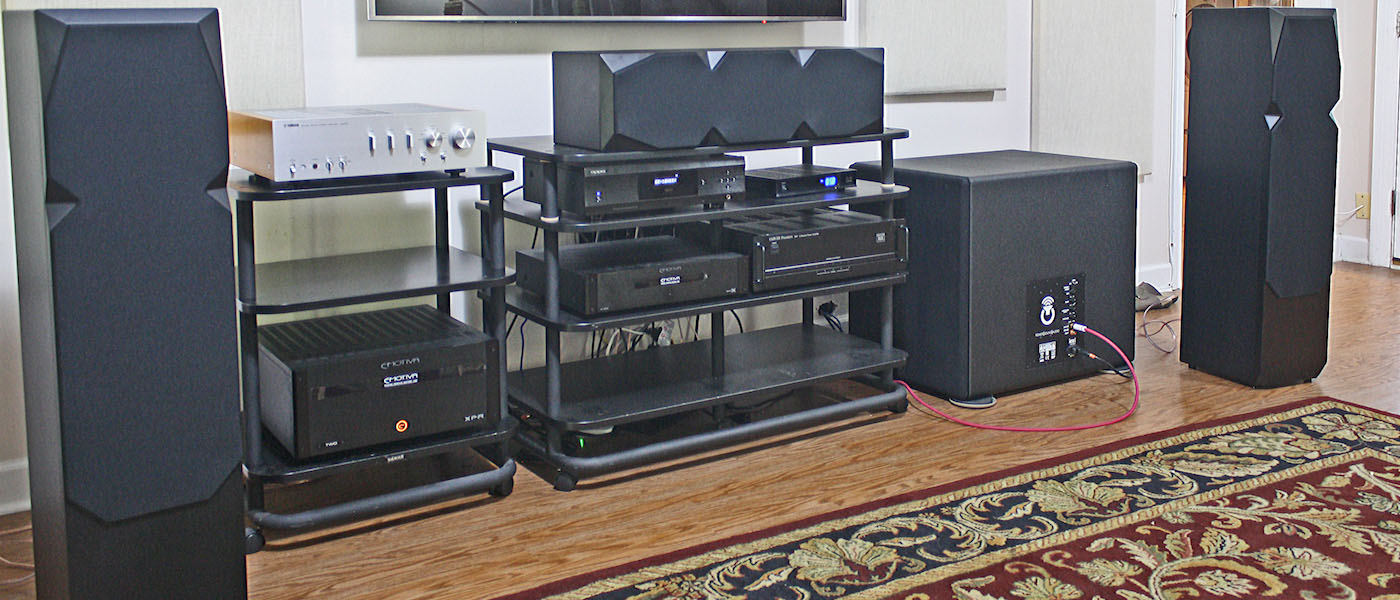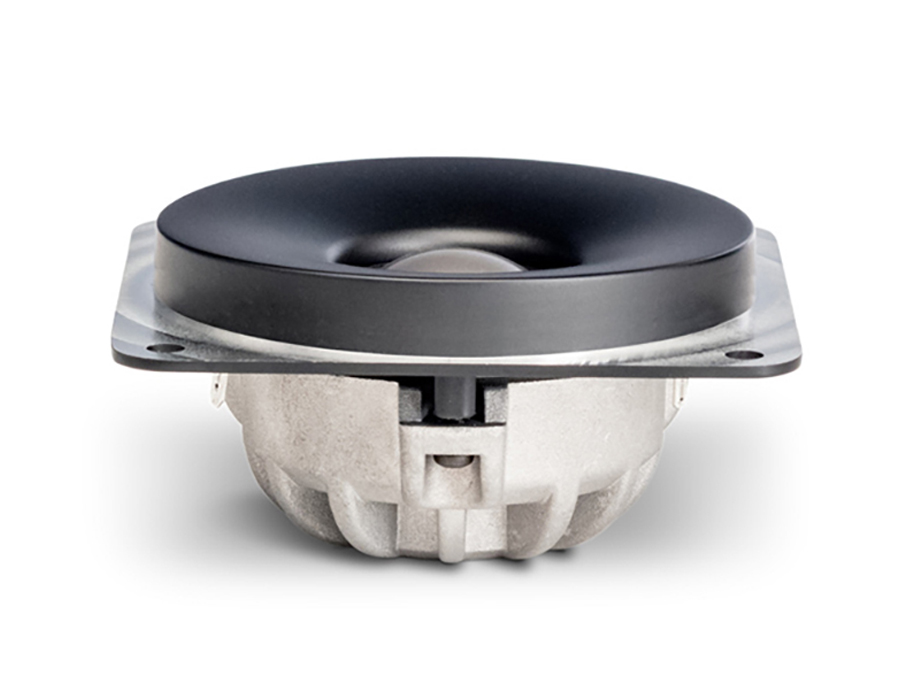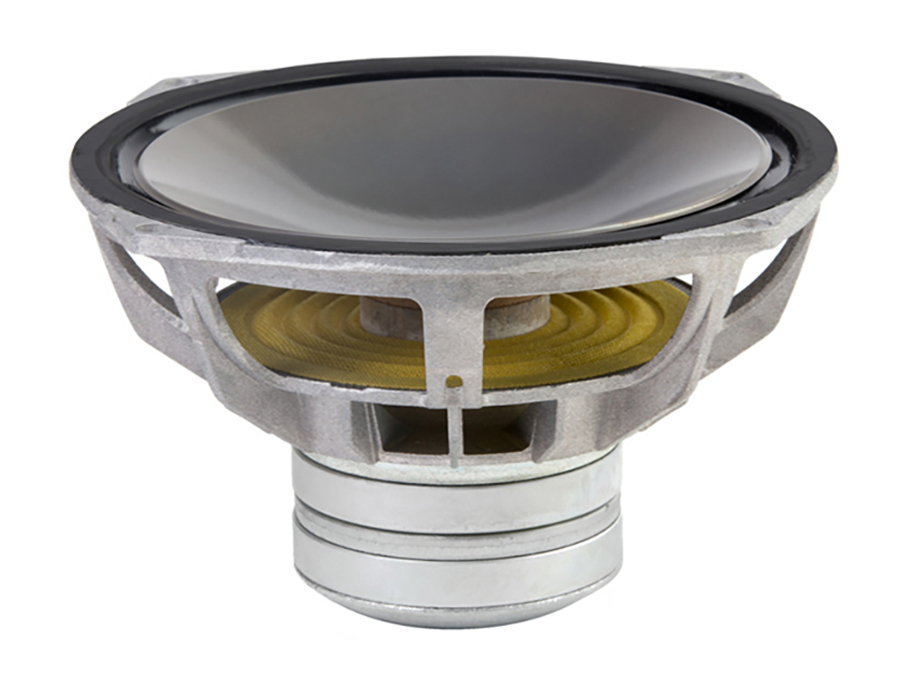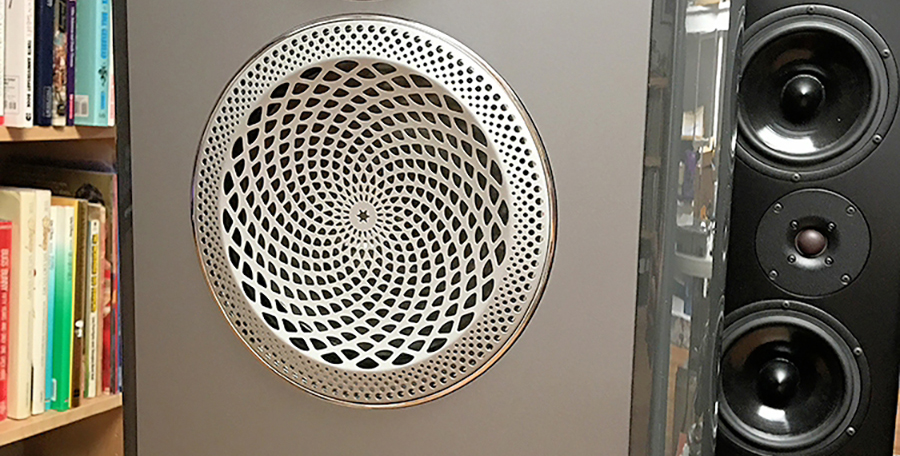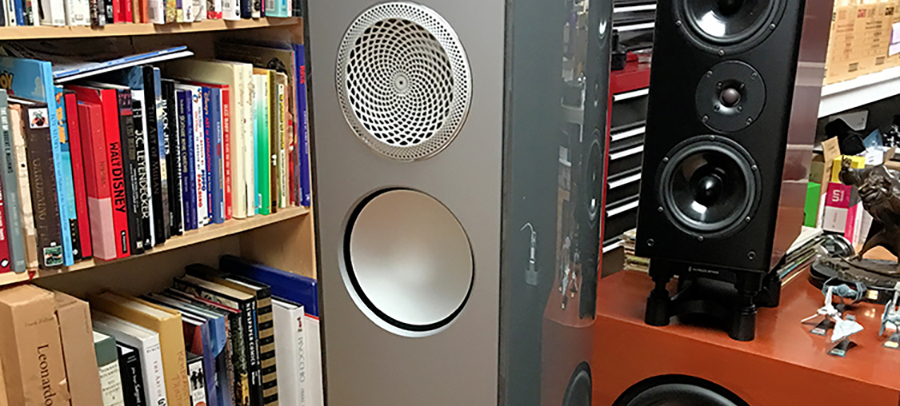The Persona 7F is a large tower speaker that pushes the envelope on pretty much every aspect of passive loudspeaker design and manufacture. From the use of pure beryllium in its tweeter and, more unusually, in its midrange driver, to the special press required to shape and bond the intricately designed cabinet structure together, Paradigm claims to have left no stone unturned in the creation of Persona. In any event, whatever science and wizardry Paradigm has obtained, from this or any of the other nine-realms (a little Thor parlance there for you), and imparted into these speakers, it works exceptionally well! The Persona 7F have to be one of the most natural and cleanest sounding speakers that I have ever come across. The alacrity of musical delivery and lack of overall distortion is immediately evident upon first listen. Combine that with a claimed bass reach that extends down to 24 Hz (and legitimately feels like it in room), Paradigm brings us a loudspeaker that appears to give quarter to no one. It’s even completely designed and manufactured in Paradigm’s Mississauga, Ontario facility making it about as “Canadian” as it gets. Not bad, eh?
Paradigm Persona 7F Loudspeaker
- Lovely natural and transparent sound.
- A 92dB sensitivity with an 8-ohm impedance makes them surprisingly easy to drive.
- You will not need subwoofers unless you are bass-obsessed.
- Beryllium tweeter and midrange drivers sound impeccable.
- Bi-wire and bi-amp capable.
- Stunning industrial design.
In 2015 Paradigm introduced a speaker called the Concept 4F at the Munich High End show. It was claimed to be a benchmark statement for everything Paradigm has developed and learned over its 35-year history. It was also a precursor for a new speaker line that was to come in the near future.
Design:
3-way Floor-Standing Loudspeaker
Low Frequency Transducers:
Two 8.5” ultra-high excursion X-PAL™ aluminum drivers featuring ART™ surrounds, triple magnets and dual 1.5” voice coils
Mid/Bass Frequency Transducer:
Single 7” Truextent® Beryllium driver with Inverse Differential Drive Neodymium motor and PPA™ lens
High Frequency Transducer:
Single 1” Truextent® Beryllium domed, ferro-fluid damped tweeter with PPA™ lens
Maximum Rated Amplifier Power:
350 Watts RMS
Frequency responce (manufacturer):
24 Hz – 45 kHz (+/-2dB) on axis
Sensitivity:
92dB (2.83V @ 1M)
Nominal Impedance:
8 Ohm
Crossover Frequency:
3 rd order electro-acoustic at 2.4 kHz and 3 rd order at 450 Hz
Enclosure Type:
Bass-Reflex via Single Down-Firing Port
Inputs:
Dual Five-Way Binding Posts, Bi-Wire and Bi-Amp Capable
Dimensions:
51.75” H x 11.875” W x 20.5” D
Weight:
144 pounds each
Finish:
High Gloss Black, White, Silver and Blue automotive grade finishes with additional custom colors upon request
MSRP:
$25000.00 (pair)
Company:
Secrets Tags:
Paradigm, Persona, 7F, Reference, Beryllium, Loudspeaker, Speaker Reviews 2018
I got a chance to see and hear the Concept 4F at CES 2016 and it was indeed visually impressive to behold. Sonically, it sounded very promising in the limited and controlled demo that we experienced. I came away from that demo convinced that Paradigm wasn’t simply horsing around with just a fancy-looking tease product. It was obvious that the company was expending some serious expense and brain-power to draw a decidedly bold red line in the high-end marketplace.
Fast forward to 2017 and Paradigm gave up its true intentions with the introduction of the complete Persona line. Made up of six speaker models and one subwoofer, the original Concept 4F looks to have been an early version of the range-topping Persona 9H model, as they have a similar driver compliment and active electronics package featuring Anthem’s ARC onboard. The Persona 7F model, which is of interest to us here, is essentially a passive version of the 9H, losing the two rear-firing 8.5-inch drivers and active processing and amplification. It is otherwise very much the same as it’s bigger brother. The Persona 7F, along with the rest of the Persona line, uses a number of technologies and features that Paradigm has “dabbled” with in the past. Beryllium tweeters, Perforated Phase- Aligning Lenses (PPA™), and Active Ridge Technology surrounds (ART™) are just a few features that, while premiering on other Paradigm products, have been fettled and refined to new levels for service on the Personas. That’s not to say that Paradigm hasn’t come up with some new ideas and twists to mix into this speaker’s genetic bouillabaisse, but we’ll talk about those shortly. For now, just be forewarned that the Persona 7F is by all accounts, simply a stunner.
Distilling it to its bare essentials, the Paradigm Persona 7F is a 3-way, 4-driver, ported bass reflex tower speaker. In that respect, it is the same approach as taken by the B&W 803 D3 that I reviewed, before the Persona’s arrival. However, as there is more than one way to skin a cat, it’s in the execution that the Paradigms and B&Ws diverge in their efforts to achieve similar goals. Heck, you could include the JBL 4367s that I reviewed earlier this year and make an interesting case-study for how three similarly sized speakers with radically different designs were developed to try to achieve the same result. I may have to revisit this idea later for a blog or technical article, but for now, let’s get back to the Personas.
Beginning with the rather elegant cabinet construction, you’ll immediately notice that there areno parallel surfaces anywhere on the body. This is done to minimize the propagation of vertical and horizontal standing waves within the cabinet itself. The exterior cabinet walls are made from seven layers of a wood-composite material sandwiched with a viscoelastic adhesive. This is then put into a custom-made press to achieve the distinctive shape of the design. Each cabinet remains locked in the press for almost a week for bonding and curing.
The enclosure is then further braced with multiple 1-inch thick wood-composite braces along with 1-inch thick top and bottom plates. A large tuned port exits through the bottom plate. The full speaker body sits upon a rather intricately designed, milled aluminum plinth. Beyond being pretty to look at, the plinth integrates a base plate that distributes the output from port, the speaker feet and risers, two sets of 5-way binding posts and a rear support spine for the speaker itself.
On the subject of aluminum, another notable design feature on all the Persona models is a single, contoured piece of aluminum mounted on the front baffle. This artful design element neatly hides all the driver mounting hardware and anchors the PPA™ lens covers of the tweeter and midrange drivers.
One of the highlighted features of the Persona line in general is the use of beryllium drivers. While we are seeing beryllium used more and more in high end speaker tweeters, the Personas are the first loudspeakers that I am aware of that actually use the material for the composition of the midrange driver’s cone. Beryllium’s excellent damping qualities, along with its low mass and superior rigidity, make it a natural for audio use. Paradigm sources their beryllium driver parts from a California based company called Materion. That company has developed a specially processed type of beryllium called Truextent®. Unlike the previous methods (vapor deposition) of employing this potentially very toxic material on a driver cone, Truextent® beryllium is rolled, repeatedly, into a foil which imbues it with a tight and uniform grain structure. This, supposedly, make it very desirable for acoustic applications.
The Persona 7F is equipped with a 1-inch, ferro-fluid- damped beryllium tweeter driver, a 7-inch midrange driver with a beryllium cone and two 8.5-inch aluminum cone bass drivers. Each of these drivers is incredibly over built with large magnets and mechanical structures. These combined with other design elements, such as dual voice coils and differential drive motors are meant to keep any wayward driver distortion in check and at bay. The bass drivers alone look like miniature subwoofers and feature the same meaty, over-molded surrounds that I saw on this subwoofer that I reviewed about a year-and- a-half ago Prestige 2000SW.
Both the tweeter and midrange drivers are each set behind rather ornate looking lattice covers. Known as Perforated Phase-Aligning driver lenses (PPA™) these covers have specifically cut patterns in them that are said to block out-of- phase frequencies and subsequently help provide a smoother output from the respective driver. They also serve a secondary function of providing protection for the beryllium drivers as the Personas do not come with any traditional speaker grilles. At first glance they reminded me of patterns that I used to draw with a Spiro- Graph toy as a child. In this case, the designs are both pretty and practical. The crossover networks employed in the Persona 7F are third order designs with the woofers handing off to the midrange at 450 Hz and the tweeter taking over from 2.4 kHz.
At almost 52-inches high and 144 pounds each, these are not teeny speakers. They will most certainly need sufficient room to breathe and should be installed and positioned with able-bodied assistance.

For this review, the connected components consisted of: an OPPO BDP-105 Universal Disc Player, Bryston BDA-3 DAC a Technics SL1200 Mk 6 turntable with a KAB fluid dampened tonearm mod and an Audio Technica VM760SLC phono cartridge, an Emotiva XPS-1 Gen 2 phono preamp, a Class D Audio SDS-470C Power amplifier (300 watts @ 8 ohm, 600 watts @ 4 ohm) and a Panamax M5500 power conditioner. Speaker wire and interconnect cable by Blue Jeans Cable.
Paradigm was kind enough to send their Western Sales Manager, the agreeable and affable Chris Sipes to help me get the Personas down into my art studio and assist with dialing them in, as best as possible, for my room. While Chris was here we got the Personas adjusted to the point where we agreed that the imaging appeared just right, but the bass seemed a little lacking. Chris assured me that they could go deeper than what we were hearing in my room but circumstances with furniture and other equipment limited my positioning options at the time he was in town. About a week later I was able reconfigure the room a bit which allowed me to experiment a little more with positioning. After some work, I believe I was able to get both the imaging as good as when Chris was here, and the bass response significantly improved over our initial attempts.
The Persona 7F are surprisingly efficient and easy to drive so one doesn’t require a ton of power to make them sing. This whole setup exercise though was a good reminder that for best results, do take the extra time to get these (and frankly any speakers) positioned just right for your room.
Let me first say that I think Paradigm has brought us something quite extraordinary with the Persona 7F. The overall styling of the speakers is both thoroughly modern and timeless. You will certainly not get tired looking at them. The quality of the automotive paint finish looks exemplary. Metallic flecks in the paint make the silver/grey finish pop in the light. Being an artist as my “day-job,” I really like and appreciate the design of the speaker’s aluminum plinth. It just looks so good aesthetically and combined with other little details like the thin chrome rings around the PPA™ lenses and the carbon fiber trim on the binding posts, you get the sense that the attention paid to all aspects of this speaker was meticulous. Sonically, the Personas have to be some of the clearest and most natural sounding loudspeakers that I have had at “Casa Lo Raso.” Once they were properly dialed into the room, they just did so much, so right that I was straining to find fault with them. And let me tell you, I was trying! I knew that I liked their clarity and natural sound quality after several weeks of listening on a daily basis. Then, after I measured them and saw that, while the in-room results were decent, the Paradigms weren’t quite as flat as I was expecting, I scrutinized them even closer. I ran all manner of Jazz, Blues, Classical, Rock and electronic music, on both vinyl and digital, through the Paradigms, looking for a weakness. Nothing of significance stood out. Male and female vocals sounded positively lovely, particularly when I was listening to vinyl. Being as efficient and easy to drive as they are, the Persona 7Fs would be quite amiable to an all-vinyl listening setup. The beryllium tweeter and midrange driver performance impressed me mightily. Track after track, and regardless of volume, I reveled in the clarity of tone and lack of distortion that these drivers presented. Strings, flutes and chimes positivity sparkled when I played orchestra material. Piano music was reproduced in an absolutely outstanding fashion with a clear and rich sound to the notes and decay.
Bass response on the Persona 7F was also exemplary, hitting deep, low and hard when the material called for it. Drums and acoustic bass lines came across as properly impactful without losing any of the details of the strings or skins. Synthesized bass had tremendous weight to it. The Persona 7Fs easily handled whatever material I threw at them and just dealt with everything effortlessly. I eventually stopped trying to find fault with these beautiful grey monoliths and just enjoyed all the wonderful music that they were giving me. The following are a few notable musical selections that I felt showed off the Paradigms during our time together:

Stan Getz and Joao Gilberto “Verve SACD:”
What more can you say about THE defining bossa nova album? This SACD has always been an excellent example of how good a vintage recording, from 1963 in this case, could sound when care is taken with the modern re-release. From the first guitar strums on “The Girl from Ipanema,” I knew I was in for a treat from the Personas.
Joao Gilberto’s soft spoken, and melodic Portuguese lyrics floated perfectly dead center between the Persona 7F towers. His very tasteful acoustic guitar work sounded appropriately full but with plenty of string detail throughout the song and I could pick up various taps and reverberations from the guitar’s body as well. Stan Getz’s tenor sax sounds almost otherworldly as it enters the tune. The image the speakers throw of that sax is positively huge, but the Personas also easily reveal the amount of control and finesse that is being exhibited by Getz on that fine instrument too. And then there is the unmistakable sound of Astruid Gilberto’s voice coming in from the left channel as she sings those famous lyrics in English. The Personas properly captured her trademark, occasionally flat, intonation as accurately as I have ever heard it. Rounding out the song, and heck the whole album, is the nice meaty acoustic bass line and the nice crisp sound to the cymbals, riding shotgun throughout.

Galen Weston “Plugged In:”
Listening to a local Toronto musician on a pair of speakers made in Toronto. What could be more appropriate than that! This is a mostly instrumental CD and Weston’s music is infused with predominantly rock and jazz sensibilities. The album kicks off with the track “Funk Opus #2” and the Personas get right to work rendering all the tonality and “crunch” that Weston can coax out of his yellow Stratocaster guitar.
That sort of crispy sounding distortion, around the edges of the notes, becomes a noticeable component of the performance when listening with the Personas. It’s just a quick but important indication that the detail these speakers can pull out of a recording is quite substantial. This continues into the song “Bensonite” which claims to be a tip-of- the-hat to jazz guitar greats George Benson and Larry Carlton. Along with the great sounding guitar work on this track, the Persona 7Fs really make you feel the thick and funky electric bass line and the kick drum hits sound tight and can rumble the gut. Deep, clean bass performance is certainly not lacking here!
There are congas and other types of Latin percussion that play throughout the track and culminate in a solo to end the song. During the solo I could really make out the slaps of hands against the drum skins and all the distinctive details that constitute that sound. On the track “Country,” Weston turns in a perfectly lovely sounding acoustic guitar performance with wonderful amounts of string detail being heard as his fingers move over the frets. The sound of reverberation from the guitar’s wooden body is also clearly discernible, sounding very solid and alive.

Lambert-Hendricks & Ross, The Hottest New Group in Jazz ” Columbia/Legacy:”
Jon Hendricks, Dave Lambert and Annie Ross made up one of the most distinctive vocal groups in jazz music. Together they had an amazing sense of musical timing and an almost trademark harmonic sensibility that influenced many a future jazz performer.
Starting with the track “Charleston Alley,” Annie Ross’s voice sounds silky smooth, placed dead center in space, as she sings the main verses. The Personas reveal a great sense of body and character to the sound of Ross’s voice, such that it’s hard for me to believe that this album was recorded in 1959! As Hendricks and Lambert join in with Ross to sing chorus, her voice hits an almost piecing falsetto that a lesser speaker could have trouble with. The Persona 7Fs, however, get it just right without a hint of breakup or glare. The same applies to the muted trumpet that plays at various points in the song. It plays loud and with great brassy detail at points, but the Personas keep it sounding live and natural without veering into the abrasive. No doubt those beryllium drivers and their fancy lens covers are paying some dividends here. There is an outstanding acoustic bass in this track as well and the Personas help you feel every note quite properly. On the tracks “Bijou” and “Centerpiece” Hendricks sings squarely from the left channel while Lambert and Ross trade center and right channel respectively between the two songs. On “Bijou” the performer’s parts trade off each other and weave in and out at points over Lambert’s central scat and verse. “Centerpiece” is mostly a tight three-part harmony. In either case the Persona 7F do a fantastic job keeping each of the vocalists well imaged, distinct and clear no matter how tight the harmony or quick the switch-up between the three. It is, honestly, almost like having them perform live in the room!

Frank Zappa with the Ensemble Modern “The Yellow Shark:”
This was the last recording Frank Zappa was directly involved with before his death in 1993. The selections on this CD are classical interpretations of some of Zappa’s back catalog along with some newer works performed by a 19-piece modern music ensemble. Besides being an inveterate tinkerer of almost everything and anything that could be used to create music, Zappa was a stickler for sound quality in his recordings.
The Yellow Shark is no exception. From the opening notes of “Dog Breath Variations” the Paradigm Personas projected this huge image of the performance hall and I felt almost surrounded by the performers themselves. The Personas easily delivered all the details of the various instruments and made it simple to identify where each performer was in the sound stage. Various background percussion elements, chimes, shakers, sticks and others were also rendered with unerring clarity. The bass from the various types of drums sounded tremendous, coming through as palpably deep and powerful. “Outrage at Valdez,” in particular, had a repeating deep drum beat from a tympani or similar type of bass drum that the Persona 7Fs just kept punching out with significant force. Thankfully, that repeating beat didn’t overpower the woodwinds that relayed the overarching melody of the piece. They were still clearly heard with all their detail. “The Girl in the Magnesium Dress” became an atmospheric and textural smorgasbord of sound, with various instruments being played, plucked and tapped in most unconventional ways. The Paradigm’s huge soundstage here really lent itself to experience this type of music properly, or as best as possible in two-channel. I do hope that someday the Zappa Family Trust will release a version of this recording with a discreet surround sound mix. It positively screams for it. The CD wraps up with “G-Spot Tornado,” a rather fast paced and complex piece that the Paradigms just pull off so effortlessly. Every instrument is playing full-out here and instead of becoming a big sonic jumble, the Personas keep it all sounding organized and sorted with every instrument in its place and clear to identify and follow. These speakers just sound big and brilliant!
Driver distortion tests of the Paradigm Persona 7F Loudspeakers were conducted using a calibrated Earthworks M30 microphone. The source device was a LYNX Two professional PC sound card using test signals created by SpectraPLUS audio measurement software. Distortion measurements were taken with the microphone placed at a 1-foot distance from the appropriate driver or port as indicated. In-room response and on/off axis measurements were performed using a calibrated UMIK-1 USB microphone attached to a Surface 3 PRO tablet running Room EQ Wizard measurement software. Nearfield measurements for on and off-axis response were taken with the microphone at a distance of 1-meter from the speaker.

This chart shows the horizontal on-axis frequency response directly compared to the 15 and 30 degree off-axis measurements. Everything below 300 Hz is governed by room modes and is less of a concern at this point with this measurement. The 0-degree and 15-degree plots track each other fairly closely particularly between 1 kHz to 14 kHz. The 30-degree shows the expected amount of decline compared to the other two plots. The interesting thing is how the upper end of all the plots move to converge in level at about 18 kHz.

This graph shows an averaged in room response that was culled from 10 measurements taken at various points around the main listening area. Unlike the on-axis measurement, this tries to give a better indication of what the speaker’s legitimate response is. The y-axis of this particular plot has been scaled to match reference measurements that I received from Paradigm for comparison. The plot appears relatively flat at this distance, particularly above 400 Hz. There seems to be a little bit of room gain that’s being taken advantage of below 120 Hz with a steep roll off in bass starting at about 26 Hz.

This is exactly the same plot as above, but we’ve zoomed in on the y-axis a little to get a closer look at variations in the waveform. We typically like to see no more than 5 dB variation in the plot to consider a speaker’s response truly “flat” and there is a little more than that variation happening on the Persona 7F. There is a gradual 4 dB “smiley-face” dip happening between 1.5 kHz and 10 kHz with a noticeable additional 2 dB peak in the response at about 13 kHz. There is also a minor response dip between 600 – 800 Hz and a bit of a pit in the response at 300 Hz. Below that point, there are variations that are expected due to room modes, but overall not too bad in the bass area.

The next figure shows the nearfield “NRC Listening Window” response, which averages five frequency response measurements: on axis and 15 degrees off axis left, right, up, and down. The dip between 600 and 800 Hz is still visible here along with the gradual “smiley-face” dip that I mentioned earlier. The deep trough in the response at about 150 Hz is due to floor bounce reflection from the bass drivers. In the future I plan to use some absorptive material on the floor during measurements to help alleviate this.
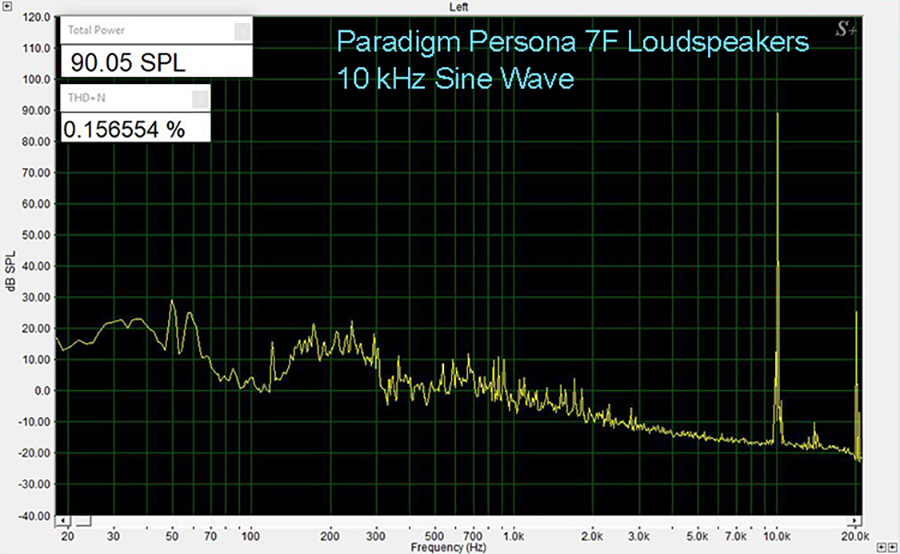
Distortion measurements for speakers are typically done with a specified sine wave, measured at a 90 dB reference point. This particular graph shows a distortion level at 10 kHz of only 0.156554% at 90 dB. Outstanding and inaudible.
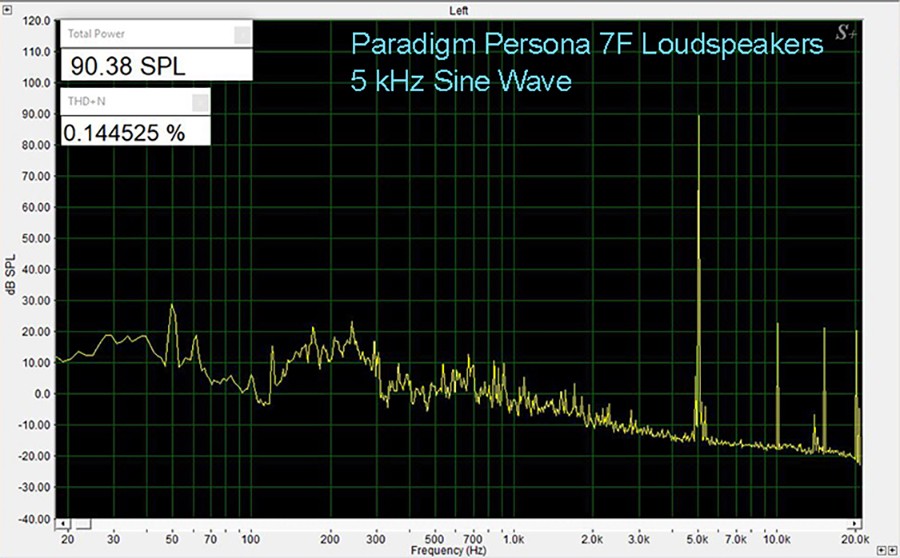
At 5 kHz the distortion level at 90 dB is lower still, at 0.144525%. Also, inaudible.
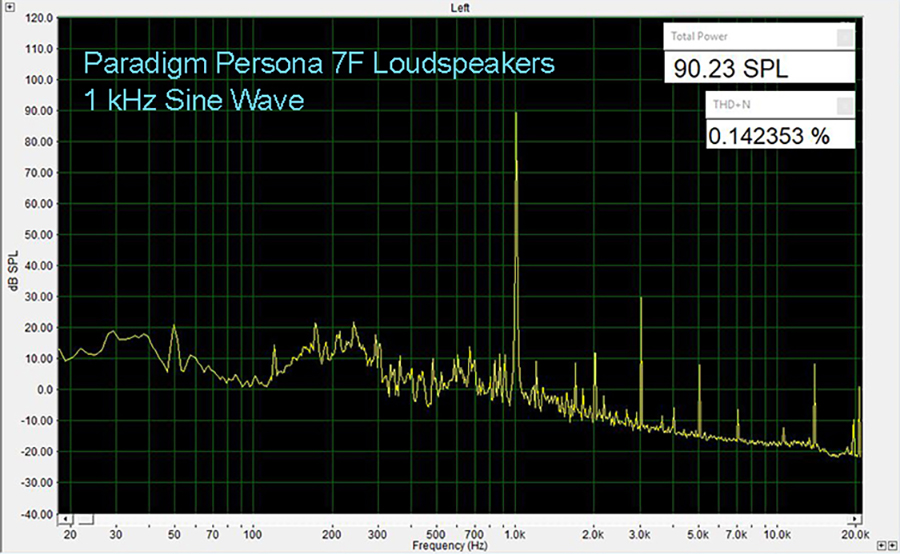
At 1 kHz the distortion level at 90 dB remains consistently low at 0.142353%.
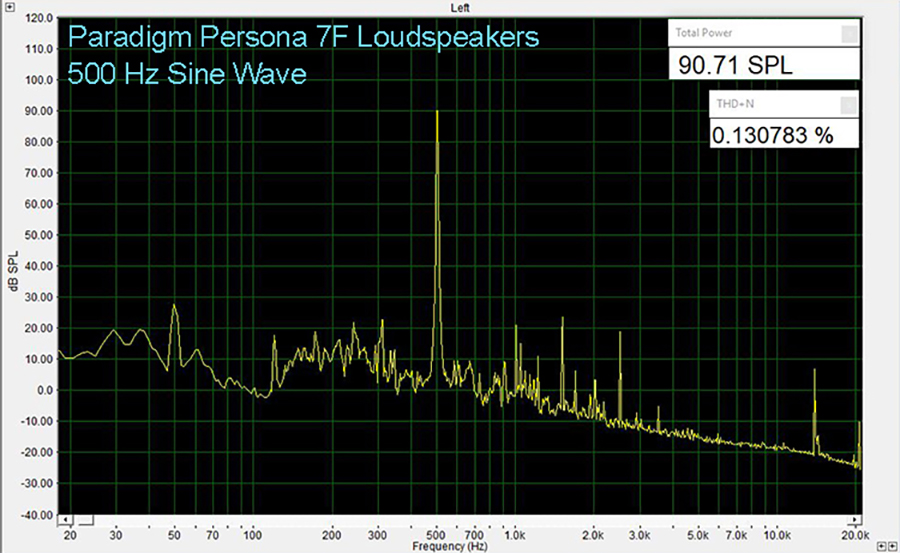
At 500 Hz the distortion level at 90 dB goes even lower to 0.130783%.

At 250 Hz the distortion level at 90 dB begins to rise ever so slightly to 0.461153%. Stillinaudible.
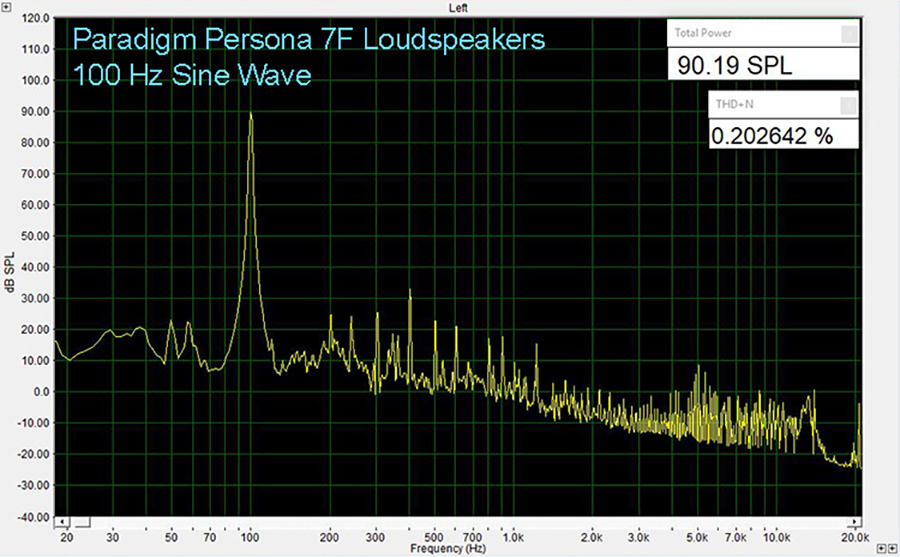
At 100 Hz the distortion level at 90 dB drops to 0.202642%.
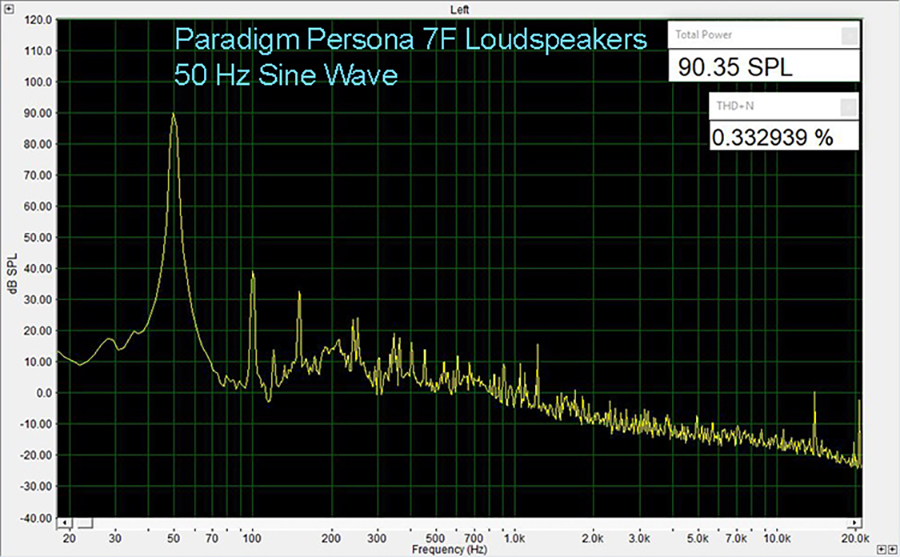
At 50Hz, the distortion level at 90 dB rises gradually to only 0.332939%! Remember that distortion levels in speakers are commonly considered to be audible at levels of 10%.
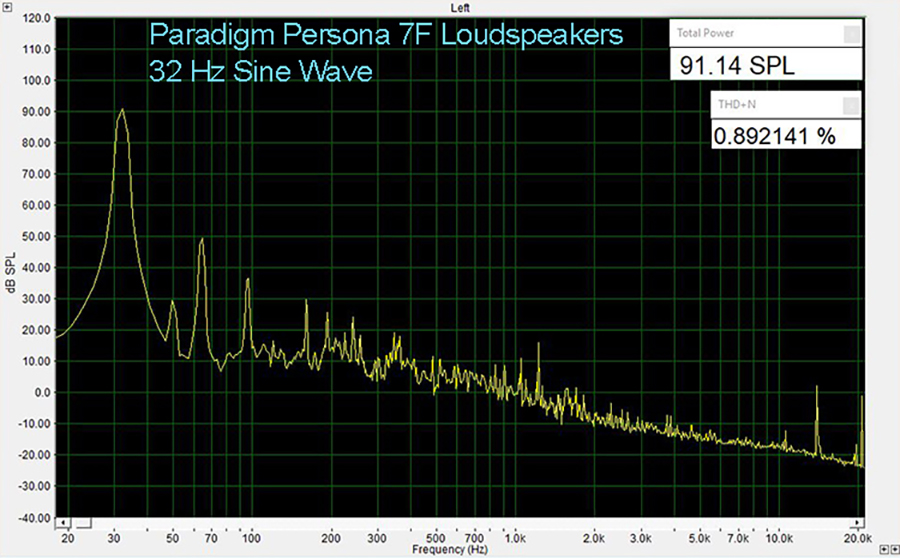
At 32 Hz the distortion level at 90 dB rises to 0.892141%. A clean sounding bass section so far.
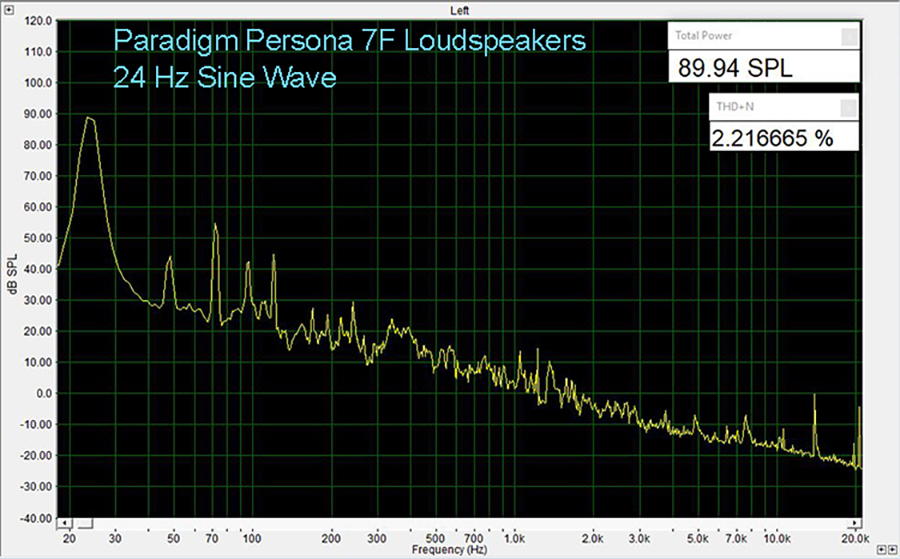
At 24 Hz the distortion level at 90 dB rises to 2.216665%. We are at the manufacturer specified limit of this speaker’s bass response and the distortion results continue to remain inaudible.
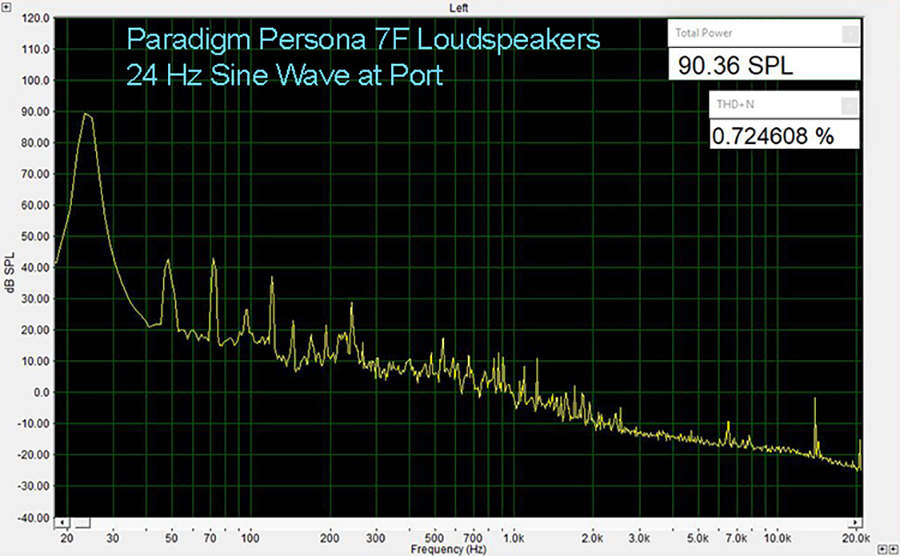
For the sake of comparison when the same 24 Hz measurement is taken at the port, where most of the sound will be emanating from at this frequency, the distortion level is only
0.724608%!

At 18 Hz we are now beginning to stress the bass limits of this speaker. At a 90 dB level the distortion jumps to 8.764080%. This is subwoofer territory and the distortion levels still remain below the point of being audible! Overall, this is remarkable performance.

THE PARADIGM PERSONA 7F LOUDSPEAKERS have an incredible sound and will make an impressive statement in your living room.
- Beautiful, modern styling.
- Advanced technologies and engineering throughout.
- Sounds as clear as daylight.
- Solid, powerful bass response.
- While the step up 9H has an active bass section, a fully active version of this speaker would be interesting.
The Paradigm Persona 7F is one of the most enjoyable speaker sets that I’ve had the pleasure of auditioning in my home. Beyond being a visually arresting example of fine industrial design, they are also sonically satisfying reproducers of music and a worthy addition to the top tier of Paradigm’s offerings. They certainly have that elusive “alive” quality to their sonic fingerprint that eludes many speakers out there in the high-end marketplace. They not only sound the part but look it as well, with a modern yet still organic design that should satisfy any prospective owner for years to come. There is no doubt that Paradigm pulled out all the stops with this one, with the beryllium drivers, advanced cabinet design and other technologies that they refined over the years. They were looking to make a statement and boy, did they. If twenty-five grand just happens to be sitting in your mad-money account and you are itching for a pair of be-all- to end-all speakers, you owe yourself a listen to the Paradigm Persona 7Fs. Outstanding is an understatement!


